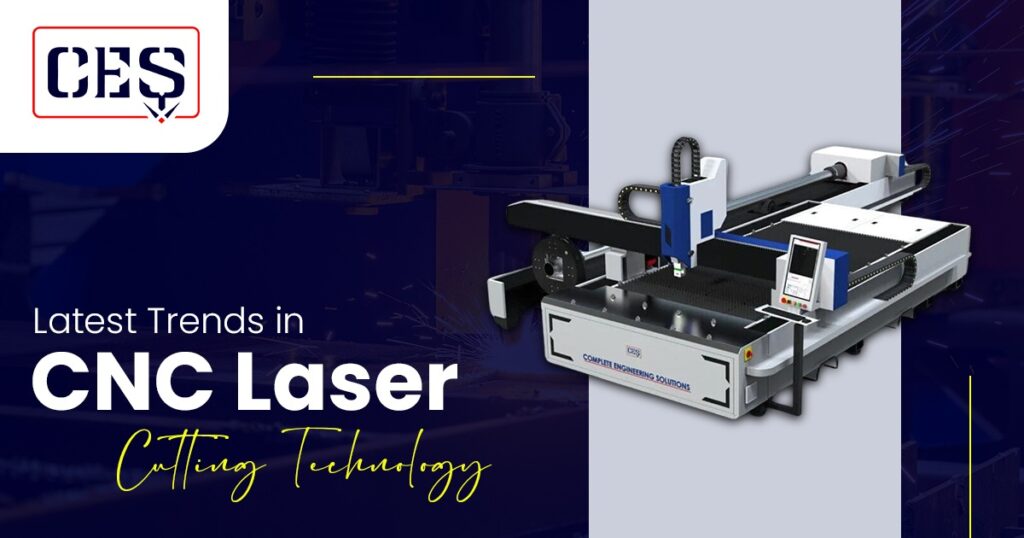From the past few decades, CNC laser cutting machine technology has advanced significantly which has transformed the manufacturing landscape with its accuracy, versatility, and speed. As industries continue to seek more efficient and effective ways to produce high-quality and advanced components, several emerging trends are shaping the future of CNC laser cutting machines. So, let’s dive into some latest trends that have redefined this dynamic technology and has given a new identity to it.
1. Cutting Speeds and Efficiency
The latest advances in laser cutting machine technology have resulted in more efficient cuts and substantially faster. Cutting speed is achieved by using powerful lasers combined with high-powered lenses and precision control systems to cut increasingly thicker materials. The laser cutting machine, as a speedier way of cutting, is ideal for mass production because it saves time and money. Increased productivity reduces energy usage and aligns with the industry’s desire for more sustainable practices.
2. Advanced Material Processing
The range of materials that CNC laser cutting machine manufacturers can process has expanded dramatically. The cutting capabilities of modern lasers are extensive and can include metals, plastics, ceramics, and composites. The use of fiber lasers in recent years has allowed for the cutting of more firmly reflective materials, such as aluminum and copper. This feature allows manufacturers to take on more complex projects and cater to a wide range of industries, from aerospace to electronics.
3. AI and Machine Learning
The use of artificial intelligence (AI) and machine learning (ML) is driving the automation and process optimization benefits of CNC laser cutting machines. Real-time analysis and optimization of cutting paths can be achieved by AI algorithms, leading to improved accuracy and a reduction in material waste. The use of machine learning enables the prediction of equipment failures and potential issues through predictive maintenance, which involves analyzing performance data to identify problems before they occur. These improvements not only increase the efficiency, but also increase the reliability of laser cutting systems.
4. Enhanced Quality
Laser cutting is distinguished by its emphasis on consistency and quality, and technical improvements have enabled these attributes. Modern CNC laser cutting systems use complex sensors and control systems to ensure high levels of precision. This accuracy minimizes the requirement for finishing and material waste. High resolution lenses with greater beam quality provide cleaner cuts and more detail, making them ideal for businesses that require exceptional standards.
5. 3D Laser Cutting
In the manufacturing sector, 3D laser cutting has emerged as a game-changer. 3D laser cutting is a newer generation of 3d printers that can cut and model 2D objects into complex 3 dimensional shapes and features. This capability is very important in industries such as automotive and aerospace, where there are many parts and complex components. The ability to cut and shape materials in 3D opens up new opportunities for design and construction, allowing for creative and functional products.
6. User-Friendly Interface
Modern CNC laser cutting systems come with innovative software solutions that provide user-friendly interfaces and increased capabilities. These software platforms give users straightforward control over cutting parameters, design changes, and process optimization. Real-time monitoring, modeling, and remote management allow operators to better manage and troubleshoot systems. Improved software solutions boost the user experience while simplifying complex tasks, making laser cutting technology more accessible and efficient.
7. Eco-Friendly Practices
Manufacturing is increasingly reliant on sustainability, and the use of CNC laser cutting technology has become more prevalent. Advances in laser technology have led to more energy-efficient systems that reduce power consumption. Furthermore, laser cutting reduces material waste and supports environmentally friendly manufacturing processes. The use of natural heating systems and material recycling supports green manufacturing projects, which are in line with international efforts to reduce the environmental impact of industrial activities.
8. Customization and Flexibility
In CNC laser cutting machine technology, the demand for customized products and flexible manufacturing processes is driving advancements. Modern technology and system requires high-level of personalization and customization for allowing rapid production of bespoke parts and components. Laser cutting offers businesses the opportunity to quickly produce customized items and quick turnaround times when it comes to producing short runs or special order items. This flexibility supports innovation and responsiveness in a fast-paced market and meets the changing needs of customers.
The latest trends highlight a shift towards greater sustainability and efficiency, reflecting the growing demands of modern manufacturing. As industries grow and embrace these innovations, CNC laser cutting machine technology remains at the forefront of manufacturing, offering unparalleled advantages in speed, performance, and versatility. By staying ahead of these trends, manufacturers can leverage the full potential of laser cutting to achieve superior results and maintain a competitive edge in a rapidly changing landscape. Additionally, if you are looking for a CNC laser cutting machine manufacturer, contact CES Laser Machine.

